

Cry it Out (CIO) - Atachment Parenting - Leave Baby to Cry. Among parents of infants these days, there is constant debate about how to respond to a baby’s cries.

On one hand, there are proponents of the “cry it out” method, where the baby is left alone to cry in the hopes that he or she will eventually stop. On the other hand, there are the “attachment parents” who respond immediately to their crying babies and attempt to soothe them using various methods including holding and cuddling. While the cry-it-out method (CIO) has been popular in previous years, attachment parenting (AP) is gaining a foothold among new parents today. Baby guru's method 'like dog training' One of Britain's leading childcare experts is facing fresh controversy this weekend after her techniques for bringing up children were described as akin to training dogs to be obedient.
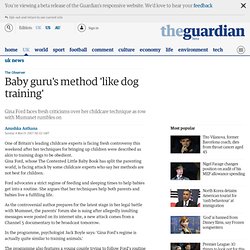
Gina Ford, whose The Contented Little Baby Book has split the parenting world, is facing attack by some childcare experts who say her methods are not best for children. Ford advocates a strict regime of feeding and sleeping times to help babies get into a routine. She argues that her techniques help both parents and babies live a fulfilling life. As the controversial author prepares for the latest stage in her legal battle with Mumsnet, the parents' forum she is suing after allegedly insulting messages were posted on its internet site, a new attack comes from a Channel 5 documentary to be broadcast tomorrow.
Attachment Styles. By Saul McLeod published 2008 John Bowlby (1969) believed that attachment was an all or nothing process.
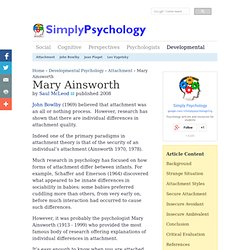
However, research has shown that there are individual differences in attachment quality. Indeed one of the primary paradigms in attachment theory is that of the security of an individual’s attachment (Ainsworth 1970, 1978). Much research in psychology has focused on how forms of attachment differ between infants. However, it was probably the psychologist Mary Ainsworth (1913 - 1999) who provided the most famous body of research offering explanations of individual differences in attachment.
It’s easy enough to know when you are attached to someone because you know how you feel when you are apart from that person, and, being an adult, you can put your feelings into words and describe how it feels. Psychologist Mary Ainsworth devised an assessment technique called the Strange Situation Classification (SSC) in order to investigate how attachments might vary between children.
Login.seam?ERIGHTS_TARGET=http%3A%2F%2Fpsycnet.apa. Login.seam?ERIGHTS_TARGET=http%3A%2F%2Fpsycnet.apa. Attachment Styles - Four Major Types of Attachment. What is Attachment?
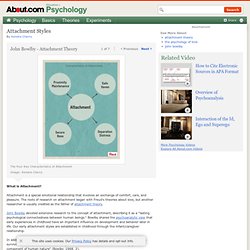
Attachment is a special emotional relationship that involves an exchange of comfort, care, and pleasure. The roots of research on attachment began with Freud's theories about love, but another researcher is usually credited as the father of attachment theory. John Bowlby devoted extensive research to the concept of attachment, describing it as a "lasting psychological connectedness between human beings. " Bowlby shared the psychoanalytic view that early experiences in childhood have an important influence on development and behavior later in life.
Our early attachment styles are established in childhood through the infant/caregiver relationship. Attachment Theory - John Bowlby. Maternal Deprivation Theory. By Saul McLeod published 2007 John Bowlby (1907 - 1990) was a psychoanalyst (like Freud) and believed that mental health and behavioral problems could be attributed to early childhood.
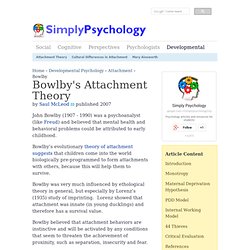
Bowlby’s evolutionary theory of attachment suggests that children come into the world biologically pre-programmed to form attachments with others, because this will help them to survive. Bowlby was very much influenced by ethological theory in general, but especially by Lorenz’s (1935) study of imprinting. Lorenz showed that attachment was innate (in young ducklings) and therefore has a survival value. Bowlby believed that attachment behaviors are instinctive and will be activated by any conditions that seem to threaten the achievement of proximity, such as separation, insecurity and fear. Bowlby (1969, 1988) also postulated that the fear of strangers represents an important survival mechanism, built in by nature. Main Points of Bowlby’s Theory 1. 2. 3. 4. They found 3 progressive stages for distress: 5. Attachment Theory: How Early Attachments Shape Behavior.
Attachment theory is focused on the relationships and bonds between people, particularly long-term relationships including those between a parent and child and between romantic partners.
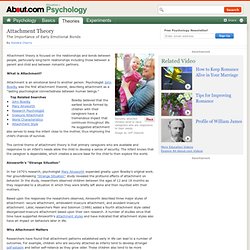
What is Attachment? Attachment is an emotional bond to another person. Psychologist John Bowlby was the first attachment theorist, describing attachment as a "lasting psychological connectedness between human beings. " Bowlby believed that the earliest bonds formed by children with their caregivers have a tremendous impact that continues throughout life. He suggested attachment also serves to keep the infant close to the mother, thus improving the child's chances of survival.